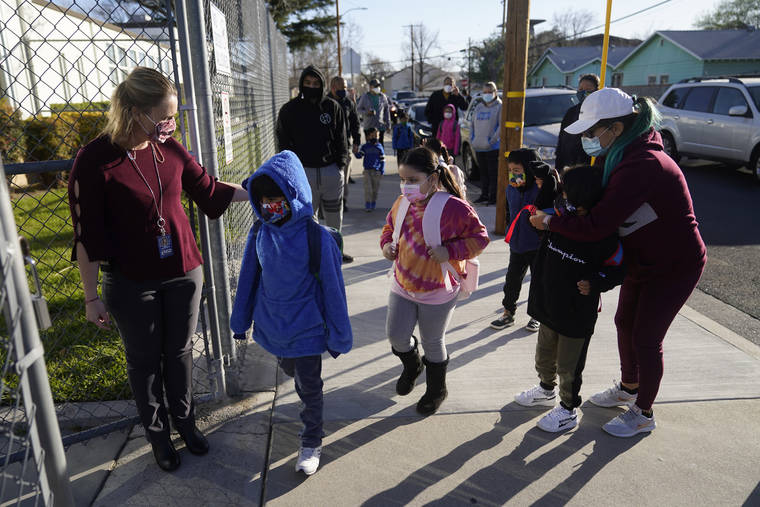SACRAMENTO, Calif. — California’s public schools could tap into $6.6 billion from the Legislature if they return to in-person instruction by the end of March, according to a new agreement announced Monday between Gov. Gavin Newsom and the state’s legislative leaders.
California, the most populous state, has 1,037 public school districts, more than 6.1 million students and about 319,000 teachers.
Most public school classes have not been held in-person since March of last year because of the coronavirus. Many districts have struggled to reach agreements with teachers’ unions on the best way to return students and staff to the classroom.
Newsom, who could face a recall election later this year spurred by his handling of the pandemic, has been at odds with legislative leaders on the best way to encourage school districts to return students to the classroom. California can’t order schools to return to in-person instruction, but state officials can offer a lot of money to those that do.
The agreement sets aside $6.6 billion for schools that return to optional in-person instruction by March 31. The bill is a deal between Newsom, Senate President Pro Tempore Toni Atkins and Assembly Speaker Anthony Rendon, all Democrats. It was confirmed by Atkins’ office. Newsom’s office has scheduled a formal announcement for late Monday morning.
The details of the plan are complicated and were confirmed by two state officials with knowledge of the plan who spoke on condition of anonymity because they were not authorized to speak about it publicly.
California counties are divided up into different coronavirus infection level tiers, with each tier having specific rules about how businesses and other public spaces can operate during the pandemic.
To be eligible for this new money, school districts in regions that fall under the most restrictive level — known as the purple tier — must return to in-person instruction at least through second grade, the officials said.
Districts must also have in-person instruction for special populations of students in all grades, the officials said, including the disabled, foster youth, the homeless, English learners, students without access to technology and students at risk of abuse and neglect.
Districts in the next highest tier, the red tier, must return to in-person instruction for all elementary school grades, plus at least one grade in middle and high school, the officials said.
The money will be distributed through the normal funding method that provides local districts with state money, the officials said, which would ensure more money for schools that serve primarily low-income students. In addition, the officials said districts would get an additional $1,000 for every homeless student they have.
To get the money, districts must meet the requirements by March 31, the officials said. Beginning April 1, for every instructional day school districts do not meet the requirements, the amount of money they are eligible to receive will go down by 1%, the officials said.
The bill would not require all students and staff to be vaccinated before returning to the classroom and it would not require districts to get approval from teachers’ unions before returning, the officials said.
The officials said testing is required for schools in the purple tier. But school districts that have already reopened or have plans to reopen in March would be exempt from testing requirements, the officials said.
Jeff Freitas, president of the California Federation of Teachers, said the plan doesn’t meet every benchmark the union sought but does make progress from prior plans. The prioritization of vaccines for teachers — 10% of the state’s allocation with a minimum of 75,000 per week — is “a huge victory,” he said. Newsom announced the focus on teacher vaccinations last month but the plan writes it into state law.
“The biggest thing I take away from here is that we are providing vaccines for educators,” Freitas said.
The CFT represents 120,000 educators from early childhood to the university system and is one of the unions that represents teachers in Los Angeles and San Francisco public schools.
The union appreciates that the plan does not force any school districts to get back to the classroom, rather it incentives districts to resume in person learning, he said. The combination of real funding, teacher vaccinations and dropping COVID-19 numbers puts the state on a path to returning kids to the classroom, he said.



Baby sitting? Because the parents work. I would think this to be the main reason for why they would bring kids into a classroom again. Just not that important to learn that yet. Surely they can find something more worthwhile to do.